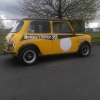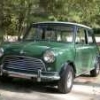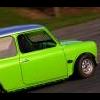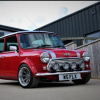My only exposure to gear hobbing equipment is in the distant past and involved WWI era equipment. Regardless, getting into the roots of the gear teeth (even with complicated CNC programming) will be difficult on relatively small gears like these.

Herringbone Gears
#16

Posted 17 November 2015 - 07:01 PM
#17

Posted 23 November 2015 - 02:02 PM
If there is a viable solution to this problem, at a decent cost, and the obvious alternatives don't materialise, I will want it on my next Mini. (But I need to finish my other project, the house, first.) £500 would be very attractive, £1000 tolerable, £1500 maybe if there was a good warranty.
I can't understant how any rotary tool can machine right into the corner of a herringbone gear. Certainly a conventional hob can't. An end-on tool like a shaped milling cutter gets a bit closer. So I am intrigued. They used to be made with the gutter in the middle as already stated, or by bolting two halves together. In some cases electron beam welding was used. If anyone knows more, please let us know. Enquiring minds always need to know....
I would suggest that there are a few things that can be done to possibly make the job easier, given that the width of the gears may have to increase, and probably should be increased anyway, to get best life from an expensive investment.
The first thing is to consider a spacer plate between block/gearbox and transfer case. Just a plain, but thick, ali plate, laser or plasma cut, quick NC machine to skim the faces and accurately position the bolt and dowel holes. Or do all the cutting on the NC mill. Now that makes the entire powerplant wider so you may need an automatic subframe, or a welded box to accomodate the mount on the clutch side. Not all that difficult, but an extension piece may be required for the gearbox input shaft. This could be designed to provide the necessary end float (any 2 of the 3 gears must be floating, and floating the clutch gear might provoke oil leaks).
Then the clutch actuating plunger will foul the inner wing. Nothing that some metal bashing can't fix, or get rid of the plunger and fit a modern hydraulic cylinder of the direct acting type. I am surprised that it has not been done already, as the benefits are immense. They are used on cars like the Ford Focus, where the gearbox is end-on to the engine, and therefore the cylinder is an annulus, and the piston has a large hole through the middle, with seals on the inner and outer diameters, to allow the gearbox input shaft to pass through. In a Mini you would just use the internal bore in conjunction with a simple tool to align it properly so the piston was concentric to the thrust bearing. Obviously the dry side of the transfer case and/or "wok" would be modified.
But consider the alternatives. Chain drive was discussed here some time back, and if viable could be a better choice, as it is more efficient. We never heard any more from a knowledgeable person on that one, but it has to be worth asking around the manufacturers of chain drives to see if it is possible. Potentially cheaper, 2 gears instead of 3, no idler bearings. Again, may need spacer plate to get more width. I would pay a decent price for that option too.
The third option is to revert, almost, to how Issigonis originally intended things, with no idler. What killed that one originally and required turning the engine round, was allegedly carbutettor icing. Maybe it was too, (can be prevented nowadays by using fuel injection!), but it also served as a convenient cover story for the fact that the original A35 gearbox synchros could not take the inertia of two large diameter gears, and a great reduction in inertia was obtained by the reduction in diamerer of the gears, even if one was added. The later gearboxes have entirely different synchros, so there "may" no longer be a problem, but a thorough thrashing for high mileage testing would be needed. (Now there is a good job for some people, getting to thrash a Mini about for as many miles and gearchanges as possible! Lots would volunteer to do it for free in their spare time, I would imagine.) Anyway, the idea is to not turn the engine round, which would be rather difficult as new gearbox castings would be required, but rather to reverse its rotation.
The hard way involves new camshaft, major changes to thrust bearings for camshaft and distributor drive, oil pump, etc. The easy way involves only a reversed camshaft drive, i.e. introducing direct gear drive (just 2 meshed gears) or, if more practicable, 2 idler gears to bridge the gap between the main gears and allow backlash adjustment. There is a highly modifiable steel backplate there already, if idlers are to be used. (May need casing mod, possibly to support outer bearings for idlers.) No change to distributor, oil pump, etc, as the camshaft will run in its intended direction, only the crankshaft rotation is reversed. Need new starter motor, although the pre-engaged type may be modifiable. Advantages: a set of two helical main drive gears, and 2 or 4 new fairly lighweight gears, to handle only camshaft drive, is thinner and less expensive than a set of 3 herringbones intended to replace the drop gears. Troublesome (noisy) chain gone for ever.
Note that reversing the engine requires the pistons and rods to be fitted in reverse orientation as the thrust side is swapped. Also if there is a large offset between bores and crankshaft center line (don't think there is on most Minis, but I can't find definitive information right now, the big bore engines have different offsets on the cylinders to squeeze them in), this is not going to work well, as there will be bad side effects on piston side load and even the combustion process, due to the changed piston velocity profile with respect to crank angle.
Oh, water pump (moderately difficult) and alternator (easy) need to be changed. Most alternators will work in either direction. It is hard to make one that doesn't. A new water pump can be machined from solid (not too expensive on NC machinery) or cast. Or, fit a serpentine poly-V belt system and drive the pump off the back of the belt. It will not slip if there is a good wrap angle around the pulley, but that puts at least one idler pulley almost up somewhere near the wiper motor area. I would just fit a blanking plate and electric water pump and fan, with temperature sensing speed control. More power saved... Driving the pump in its usual direction by a short belt from the second idler (through a seal in the timing cover) might also be possible if idler gears are used.
Oh, and if the clutch friction plate is sprung, it will need reversing, which may involve some machining. And, if the clutch pressure plate uses drive straps, they will need assembling backwards as the torque will be in the other direction. Not rocket science.
Reversing the engine rotation seems to me to potentially give the most overall benefit as part of the large power loss of the drop gears is removed, however it all depends on the synchros being robust enough to have a good life. Chain drive is almost as good, but again adds inertia which will stress the synchros. If the synchros are not up to it, or can't be improved, herringbone drop gears are the way to go.
#18

Posted 23 November 2015 - 02:17 PM
Would a spacer plate not also require a longer crank nose? The flywheel would surely have to move out with the transfer casing to maintain its clearance.
And a longer primary gear to accommodate the clutch plate being further away (although the primary would be part of the herringbone 'kit' anyway).
#19

Posted 23 November 2015 - 04:39 PM
The spacer would indeed need a dfferent crank all toghether.
An option is to machin the gearbox casing and transfer casing to allow for the gears to be a bit wider.
cutting these gears is really not easy, but the guy wjo will be cutting them has been born in this industry ( inherited the company of his father). They have a special gear cutting machine for it, I would love to supply moreinfo on it, but its been quite a while since Ive seen it on the inside, I now communicate a lot over phone/email due to my every so bussy life.
I like the idea of reversing the block ( opens more possibilities for other mods) But the new gearbox casing woul be needed anyway, or a spacer plate been mad to accomodate the oil pipe.
Im waiting for the engineer to cut the first set of 3 gears now so I can test them.? Will be tested in a 135 bhp ( 115 wheel bhp) race engine, then they'll be trashed for a full season and be inspected . Just to start .
cheers
#20

Posted 23 November 2015 - 04:51 PM
I don't think a new crank would necessarily be required, possibly just a new boss for the flywheel. The primary gear would be new in any case. But it is a good point that I had forgotten about.
But what does reversing the block, as opposed to just reversing the rotation, do for you? You need new castings, and most likely a new crank. Or does it fit the other way round? Never tried!
Edited by tiger99, 23 November 2015 - 04:54 PM.
#21

Posted 24 November 2015 - 12:51 AM
Some interesting armchair engineering.
If you're serious about taking it into the workshop and getting a batch run together, it'll need to be a simple enough solution to suit all the interested punters. So, some sort of transfer drive that will fit in place of the original with minimal modification to other bits.
If you go with herringbones at the same helix angle, won't you be half way towards the noisy meshing you get with straight cuts?
It seems to me, since the idler axial thrust force is the issue, then the simplest solution would be to produce, just, a better idler & bearings that can handle more. Taper bearing???
#22

Posted 24 November 2015 - 09:15 PM
I think that taper roller bearings have been discussed previously and are, in principle, a very good idea. The one significant problem is that the end float will not be set with sufficient accuracy in the usual way, so the transfer case will need to be machined, and some kind of adjuster installed, that can be set up once the transfer case to engine and box bolts are torqued up. That needs to be fairly compact to clear the flywheel, and it must not leak oil. The main casing and transfer case will need machining anyway, for much larger OD of the bearings, and if there is not enough metal (very likely) it will have to be welded in and the castings remachined.
Maybe a better way is to put a fixed shaft in the casing and machine out the idler gear to take the bearings, if they can be spaced sufficiently far apart for stability?
Doable? Probably. Worthwhile? Yes, if it works. Cost-effective? Probably, despite casting mods.
But it will not be as good as herringbome gears, nor will it reduce power loss like chain drive or engine rotation reversal and elimination of idler gear.
Someone should try it. The alternatives should all be tried too.
#23

Posted 24 November 2015 - 09:30 PM
Some interesting armchair engineering.
If you're serious about taking it into the workshop and getting a batch run together, it'll need to be a simple enough solution to suit all the interested punters. So, some sort of transfer drive that will fit in place of the original with minimal modification to other bits.
If you go with herringbones at the same helix angle, won't you be half way towards the noisy meshing you get with straight cuts?
It seems to me, since the idler axial thrust force is the issue, then the simplest solution would be to produce, just, a better idler & bearings that can handle more. Taper bearing???
I'd imagine the simplest solution to the side loading issue would be to produce a helical version of the drop gears Swiftune sell? Clicky
Attached Files
#24

Posted 24 November 2015 - 09:36 PM
http://www.minispare...|Back to search
Edited by GraemeC, 24 November 2015 - 09:49 PM.
#25

Posted 24 November 2015 - 09:41 PM
There has been a lot of work done in research of shallower helix patterns on gearing. I wonder if this would be a little easier to produce? Or what about larger tooth profiles?
Edited by Steve220, 24 November 2015 - 09:44 PM.
#26

Posted 24 November 2015 - 09:42 PM
Well that's that then.
#27

Posted 25 November 2015 - 12:15 AM
Somewhere this idea seemed to have strayed a long way! With talk of modified gearbox cases, spacers for cranks etc,,,,
Some interesting armchair engineering.
If you're serious about taking it into the workshop and getting a batch run together, it'll need to be a simple enough solution to suit all the interested punters. So, some sort of transfer drive that will fit in place of the original with minimal modification to other bits.
If you go with herringbones at the same helix angle, won't you be half way towards the noisy meshing you get with straight cuts?
It seems to me, since the idler axial thrust force is the issue, then the simplest solution would be to produce, just, a better idler & bearings that can handle more. Taper bearing???
I'd imagine the simplest solution to the side loading issue would be to produce a helical version of the drop gears Swiftune sell? Clicky
Straight Cuts are easy to do the bearing conversion on, but having 'visited' the Helical situation a few times over the years, it's not nearly so easy, though can be done.
The solution lies in using ball angular thrust bearings rather than a tapered roller, as the end up too wide for the space. The straight cut conversion all (well, all the one's I've looked at) use a roller type bearing and so can't deal with side thrusts.
Reading some of the posts here (all very good) I kinda get the impression that people are having different (though not at all wrong) ideas as to what the final outcome should be or put another way, why it's being done in the first place.
Edited by Moke Spider, 25 November 2015 - 12:16 AM.
#28

Posted 28 November 2015 - 12:25 PM
I am not sure that angular contact ball races, which is what I assume you mean, will handle the load, as the contact area is far less than that of tapered rollers. Consider why people move from angular contact ball races to taper rollers in their hubs, for instance.
But then you may tell me that modern cars, with their factory assembled complete hub units, are using balls again. That is because the balls can accept a more random amount of preload than rollers, which makes manufacturing easier and cheaper. A bodge, really.
Ball races are available with a variety of contact angles, and your point is worthy of investigation.
#29

Posted 28 November 2015 - 07:06 PM
Yes, I agree 100% that angular contacts have far less load capability than tapered rollers, however when I went looking for a tapered roller that would fit, there just isn't any. Angular Contacts are available in thinner widths and they have well enough load capability for this application. Still not sure? Have a look at the earlier Idler Gear needle rollers and compare them to a ball race or angular contact.
#30

Posted 28 November 2015 - 07:21 PM
A point to note with the chain drive option is the loading on the gearbox casing will be different. The chain would pull upwards trying to rip the bearings out of the casing rather than the drop gears which push sideways and distributed into the casing which it's designed for. Whether that would actually be a problem would have to be tested i suppose.
1 user(s) are reading this topic
0 members, 1 guests, 0 anonymous users



















